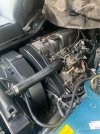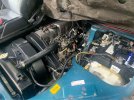Thibaut. B
New Member
Hello everyone,
I'm new to the forum and I'm about to buy a Delica L300. I'd like to have your opinions on the van in question. Here's the ad description + pic.
What do you think about rust stains on the front? Is it easy to treat?
Any advice or opinion is more than welcome .
.
Thanks





I'm new to the forum and I'm about to buy a Delica L300. I'd like to have your opinions on the van in question. Here's the ad description + pic.
Mitsubishi Delica L[hidden information] 2.5L Turbo Diesel.
Imported from Japan right hand drive!
Strong point:
-Mechanics of the vehicle are in great condition
Virtually no rust on the underside of the vehicle - the frame is in top condition
Only 189,000 kilos for a diesel engine - that's not even half its life yet!
-Oil change every 5000 kilos
-2 Batteries and a 110v heavy-duty alternator all new from last year
-ready to go camping now
-Shocks changed this winter
-brakes 1 year old
-SAAQ inspection in April 2023 (proof)
-Rustproofing treatment
-Windshield changed this winter like new
Weak points:
-bodywork in need of love
-timing belt will be about 10000 kilos
It's not perfect, it's a project and still a 30-year-old vehicle!
What do you think about rust stains on the front? Is it easy to treat?
Any advice or opinion is more than welcome
Thanks






